Foreword: The most feared production of DIY friends is the speaker. The reason is that it is not easy to choose a good performance and it is not easy to buy. Usually I hear someone introduce me to buy an A speaker and a B crossover. The sound is not right. Make your own crossover and find that it is difficult to select the crossover point. Even if you have finished the production and how to tune it, there is no standard to refer to, but it will be daunting.
Another frightening thing is the speaker box. It is very easy to buy MFD wood board materials in Taiwan, such as B & Q or building materials shops, and it is very convenient to help you cut the size. Really? â”…. You will find that there are more and more wooden tools in the end, because you have to repair the edges and dig holes, etc. You can do the same work â”…â”… In the end, everything is worth it, but failed. The factory-made products can already be bought at a cost.
Why are there so many people wanting to jump into the DIY world? For me, it ’s ┅┅Wait a bit and say it first. This is my opinion. If your idea is similar to mine, it ’s a coincidence.
(1) The factory machine is too expensive, so it is cheaper to make it by yourself. (The reason for telling his wife)
(2) Listening to how nice someone makes a speaker, I also want to give it a try.
(3) Of course, practice skills.
What is your DIY reason?

Caption: This is the finished photo of the two-tone small speaker produced by the author of this article, very beautiful!
The idea of ​​making loudspeakers made a lot of DIY things from the time of reading, and my appetite became bigger when I entered the workplace. I bought a lot of factory machines such as Mclntosh, AR speakers, Hafler backstage, Chario speakers, JBL speakers, etc ... And I have a pair of 3 / 5a for a long period of time. In order to have a fever, I even changed the original wooden box. In the end, the sound did not seem to be much worse. Is there someone who did white work like me without realizing it?
Therefore, basic kung fu still needs to be practiced, and then start. In the following period, there was no DIY for another 10 years. I always thought that the DIY population decreased a lot, and many DIY kit manufacturers also transformed to supply factory opportunities one by one. It was only recently that the rise of the Internet network found that the population who liked DIY has not decreased. In order to lazily find suitable products on the Internet, I accidentally found that the speakers sold by netizens have large rubber overhanging strokes of the bass unit of the speaker, which can withstand Large dynamic energy, and Vifa tweeters are also used in many high-priced products, and the selling price is also very reasonable. The service of netizens is also good. The reply action seems to be a bit slow. The network must rely on fast service to operate well. This is A little suggestion.
The analysis work before the hands-on production did not immediately produce the work. First check whether the materials and tools are ready. The kit provided by the netizen includes wooden boxes and crossover materials, but it is strange to find the speaker terminals. However, it does not affect the progress of the plan. At the beginning, I had a habit of analyzing it first, not to doubt that the original design was mainly determined to be correct and could save a lot of testing time.
The designer of this pair of speakers is a DIY player in the United States. The American nationality prefers a warm tone. This is a gap between me and the mediocre, balanced tone. Of course, just looking at the design can not see the direction of the tone. The original design is divided. The frequency point is 2.5KHz. The simulation result by PSPice is the same as the designer's setting result. Remember that the crossover frequency used by the American author Gan Li ’s two-way speaker production many years ago was 3.5KHz, but look at the original factory. The frequency characteristic starts to be uneven above 2KHz, but if you select too low a tweeter, the low-frequency power will increase, and if the crossover point is too high, the mid-high frequency diffusion angle will be affected, so it makes sense to choose 2.5KHz.
The originally designed crossover treble adopts 24dB / oct design while the bass uses 6dB / oct and an impedance equalization network around 10K to design. The advantage is that the slope is steep enough and the inductance brought by 18dB / oct design is reduced DC impedance reduces efficiency, because there is only one L3 string on the speaker and the output of the rear stage:
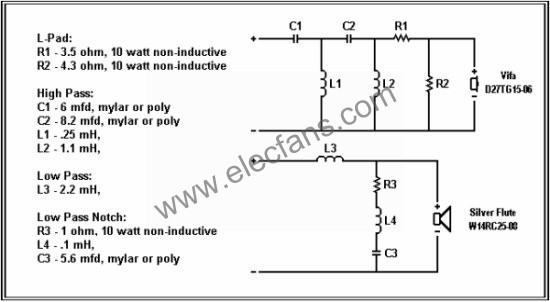
Caption: Circuit diagram of the original crossover.
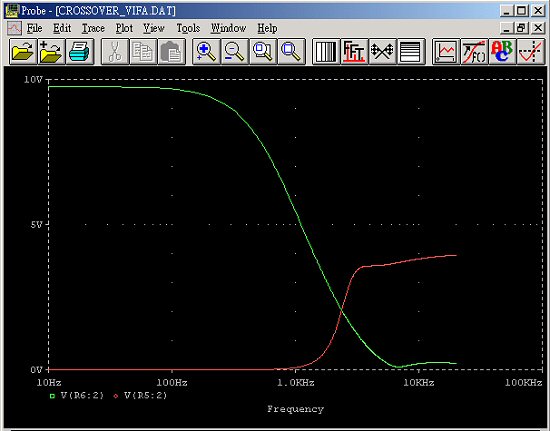
Caption: Simulation analysis results of the original design.
The original netizen's introduction of the speaker. The largest DIY speaker in the United States, the largest station in Madisound, the Silverflute W14RC25-08 5.25 "bass unit, which was highly praised by the Madisound DIY Forum. , To create a high-quality and loud audiophile speaker system, don't be fooled by its approachable price, W14RC25-08 is really a good 5 inch bass unit, compared to Vifa's evergreen P13W Nothing less.


Caption: The frequency response graph provided by the original factory, you can see uneven response above 2K
W14RC25-08 Parameters: Bass unit parameters:
• Frequency Range: 43- 9000 Hz
• Sd: 0.0087 m2
• Fs: 43 Hz
• Re: 7.3 ohms
• Imp .: 8 ohms
• BL: 6.24
• Qms: 3.269 / Qes: 0.389 / Qts: 0.348
• Krm: 0.876 / Kxm: 11.55
• Erm: 0.881 / Exm: 0.691
• Vas: 18.92
• Cms: 1760.5
• Le: 0.77
• Mms: 7.58g
• VC Ø: 25 mm
• X-max: 3.5 mm
• Flange: 142 mm
• dB: 87
• Power: 60 watts
• Cutout: 122 mm / Depth: 67 mm
• Suggested Box Alignment: QB3 (Vented)
• Box Volume (Vb): 10 liters
• Port Length: 4.25 "/ Port Diameter: 1.5"
• Fb: 51 Hz
• F3: 55 Hz
The volume design of the enclosed horn confirms:
QTC = 0.707
VAB = VAS / [(QTC / QTS) -1]
VAB = the required volume of the speaker, cubic feet
VAS = speaker compliance (equivalent capacity, cubic feet)
QTC = system design Q value
QTS = total Q value of the speaker unit resonance frequency fc
fc = 1 / 2fs [(1 / VAB + 1 / VAS) / 1 / VAS]
The calculation result through the formula is as follows: VAB = 0.213641 cubic feet is about 6 liters, and the speaker box made by the net is similar. , Fc = 72.23 Hz Good data.
Start the construction and confirm that the original design concept can start to be produced by hand. The crossover is made by PCB, which is beautiful and easy to install. This time, the etching method is not used but the knife mark is used to remove the copper foil. Simple and time-consuming.
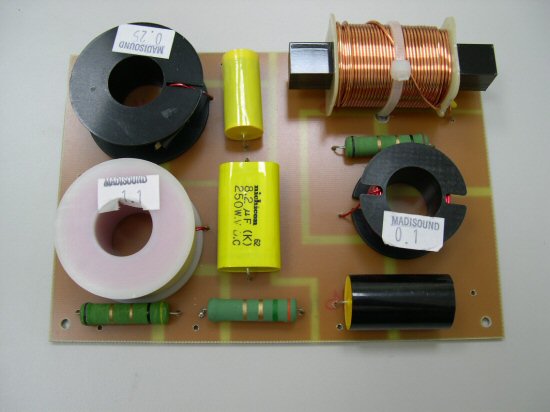
What is the way to remove copper foil from knife marks? In fact, it is very simple. First, after planning the location of the component, draw a rectangular trace on the PCB directly with an oil-based pen (draw the thinned copper interval, such as 1mm ~ 2mm wide) Then, as long as a knife mark is drawn on the edge of the line, as long as the copper thin is separated from the substrate by using a utility knife, you can use needle-nose pliers to pull up the unnecessary copper thin.

Caption: Solder the OFC speaker wire, it is a little thick and it is difficult to solder while fixing the component with silicone glue.
The internal processing of the cabinet uses 3M asphalt spray for car sound insulation. B & Q sells a bottle of 450 yuan, which can be processed multiple times to increase the thickness. It is reminded that the speaker terminal must be pasted before construction. After the construction is completed, remove the sticker to keep it. There is no tar spray in the hole, and you must wear a N95 mask or the entire nostril will be tar. 
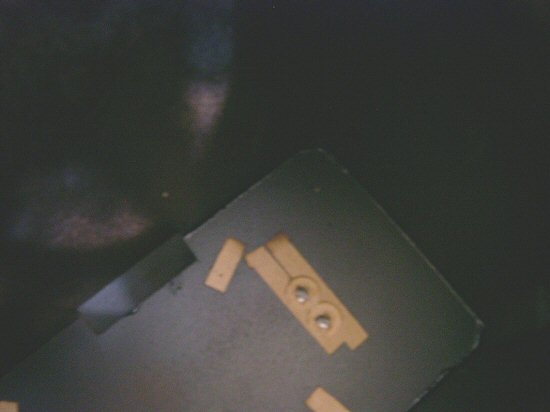
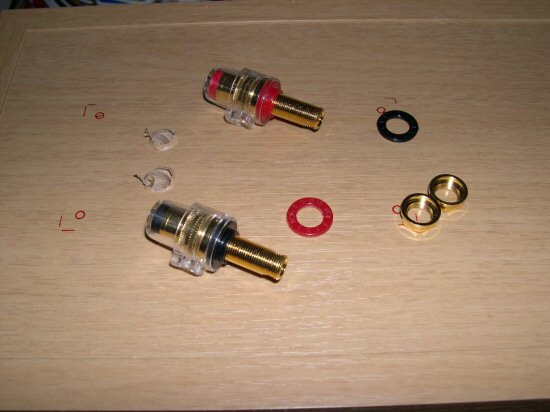
Caption: The self-purchased gold-plated terminal has good quality, that is, the hole diameter should be enlarged, the thickness of the wood board should be processed to be thinner, and the speaker terminal must be air-tight.


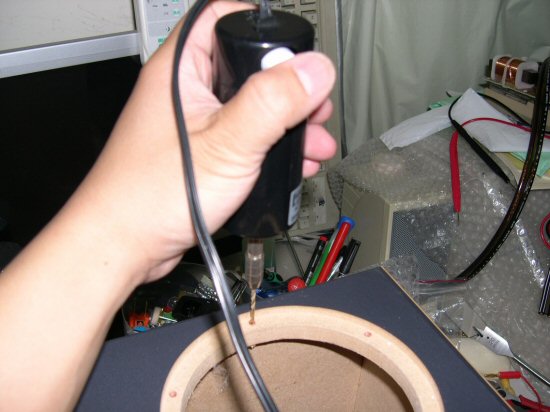
Picture: A small hole is pre-drilled in the fixing hole of the speaker to prevent the board from being deformed by screws.

Caption: Cutting the sponge ring can make the airtight.

To fix the speaker, you must hook the screwdriver of the thumb ring to prevent accidental injury to the hanging edge of the speaker. The screw is imported from Japan. It was originally used for fixing in the car. The quality is very good. At the same time, add more sound-absorbing cotton but not too much. You can reduce the box sound. If the sound is a little tight and you ca n’t let go, it means too much. This is also part of the tuning technique, and it almost makes the screw hole slip. Because it is removed too many times.
The first thing after completion is to test with an instrument to see the overall response? Tested in 5 ping space, room temperature 26 ℃, the equipment used is PHONIC frequency scanner, it can output 20Hz ~ 20KHz pink dry sound or computer connection to select frequency output, very good for preliminary test speakers and modified crossover Use, test, must be tested in accordance with recognized methods (one meter in front of the speaker) in order to get a correct judgment.
It was found that the overall frequency response of the original design was very flat, but it was slightly higher at about 1K ~ 2K. The bass began to decline at 80Hz, but it was acceptable for a 5-inch small speaker. The room temperature rose by about 1 ° C in 4 hours Fully open, maybe you can write a test report of room temperature and hearing, because it is found that the higher the room temperature will affect the mood).
The efficiency of the small speaker is not as high as that of 3 / 5a. Therefore, it is not necessary to use the vacuum tube to measure afterwards, otherwise the temperature of the small room will rise quickly, and his unique tone will also cause misjudgment. The test CD is shown in the following figure, which should be familiar to many people. Normally, my habit starts with the vocals from the microphone. The first sound is that the midrange sound is too bright. The sound will be unacceptable. The low volume is too low and the high sound is very smooth. I listened for two or three hours. The sound device may be slightly higher than 1K ~ 2K. It will be very tiring tomorrow at 2:00 AM!
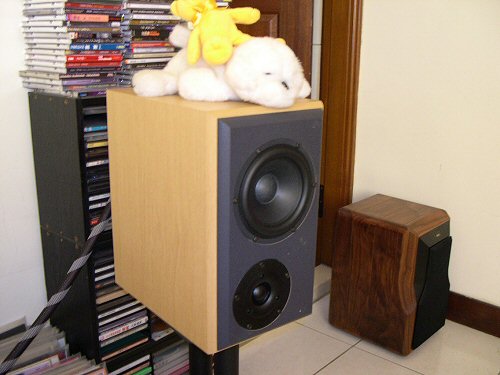

Caption: On the ground is a hand-made Chario speaker from Italy, and the newly completed Dabao No. 2 integrated amplifier is under Mclntosh.
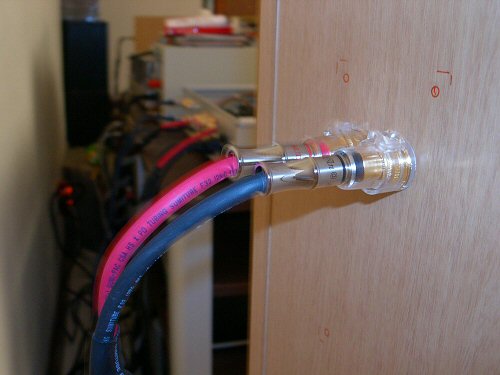

Use equipment
(1) Self-made two-in-one DZ OP134 and FET front stage can switch different tones at any time.
(2) Hafler 220 110W * 2 post grade.
(3) Mclntosh Mc2255 250W * 2.
(4) Mclntosh C32 pre-level.
(5) DZ 6BQ5 NON 15W rear stage.
(6) DZ Dabao No.2.
(7) Shure 57 microphone.
(8) Infrared thermometer (measure room temperature and vacuum tube temperature, mood index).
Compare speakers
(1) Chario Bookshelf Speaker
(2) AR3a
(3) KEF 3 / 5a
It will be the beginning of a long pain (tuning)
In the end, everything succeeds smoothly, so do n’t be afraid ┅ .. Remove the speaker, the original crossover will not move for the time being, and make another crossover to adjust the sound (as shown below) It is more convenient to replace components, and also use PAA2 to assist testing. Some DIY people love it the most.
Optic fiber clousure dome type is applied in the junction and protecting of the fiber.It can be place with the aerial cable or buried in earth or put in the pipeline.The outer part and the fusing part of the clousure are made of the project plastic with the virtue .
Fiber Optic Splice Closure is a Fiber Infrastructure System Technology. It is the environmentally sealed enclosure for the fiber management system that provides the functions of splice and passive component integration in the external network. Single-ended design. Base and dome are sealed with a clamp and O-ring system, 16 round entry/exit ports for drop cables and 1 oval port for looped cable.
Fiber Optic Enclosure,Dome Enclosure,Fiber Dome Closure,Optical Dome Closure
Chengdu Xinruixin Optical Communication Technology Co.,Ltd , https://www.xrxoptic.com